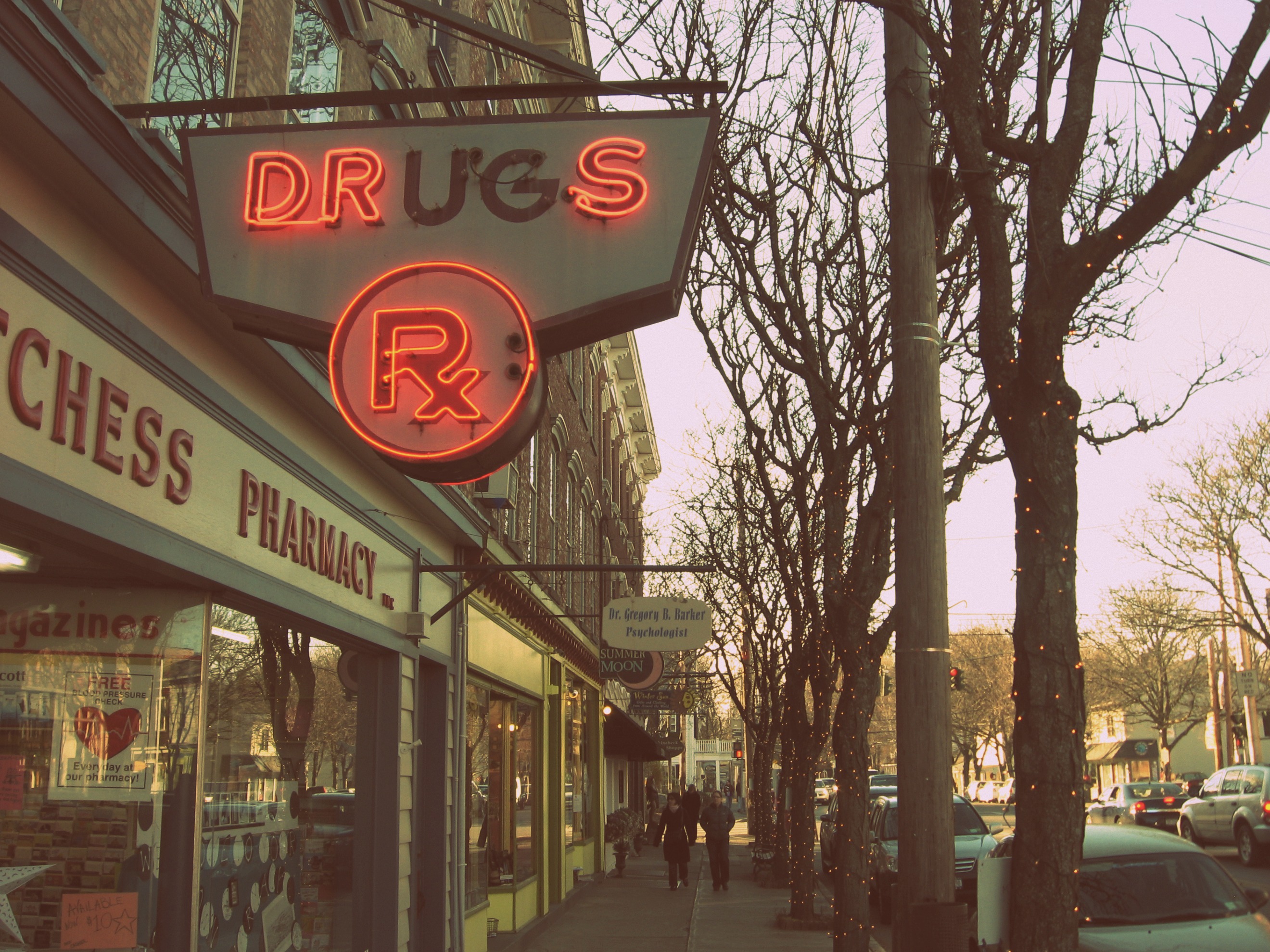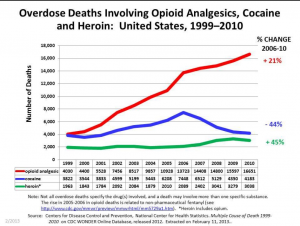Prescription opioids and heroin (from this point on summarily referred to as opioids; despite differences in legality, they both have opiate bases and fall under a shared political umbrella) have created the latest substance-related epidemic in America.[1] In a rare frenzy of bipartisanship, the House of Representatives passed 18 opioid-related bills during one week in May, while President Obama has been pushing for an additional $1.1 billion to combat the crisis since February.[2]
Questions exist about whether past epidemics were truly epidemics or products of sensationalized media and political manipulation (The truth probably lies somewhere in the middle — I’ll have more on this at some point in the future), but opioids have created a legitimate public health challenge in many communities across the United States. More than 29,000 people died from opioid overdoses in 2014, and drug overdose deaths have surpassed vehicle accidents and shootings as the leading cause of injury death in the United States.[3][4][1] That’s real, that’s scary, and that needs to be addressed.
However, as opioids have increasingly become a policy priority, a number of Black and brown Americans have voiced frustration over the sudden change of heart from many politicians and law enforcement officers, who have transitioned from calls for law and order to compassion and rehabilitation. In October, Katharine Seelye wrote a piece in the New York Times about this change in philosophy among our white populace. One officer, Eric Adams, told her, “The way I look at addiction now is completely different. I can’t tell you what changed inside of me, but these are people and they have a purpose in life.”[5]
Well, Mr. Adams, I’m not sure what changed inside of you either, but I’ll venture a guess. The way many Americans perceive substance-dependent people has changed not because they’ve recognized the humanity of the Black and brown Americans we previously persecuted, but because the face of addiction has shifted with this latest epidemic – we now know that Eric Adams’ cousin is just as (or more) likely to use as his Black and brown counterparts. Over the past decade, 90 percent of first-time heroin users have been white.[6] As of 2014, white people overdose from opioids at over twice the rate of Black Americans and 3.5 times the rate of Latinx Americans.[7][2] Death rates are rising for middle-aged white Americans, and opioids are largely behind this trend.[8]
The crack scare was “their” problem, and the opioid crisis is “our” problem. That’s frustrating. It’s exasperating to hear government officials urgently call for a move toward treatment as they quietly ignore that their justice systems still hold thousands of people of color under correctional control for drug offenses. In my eyes, it’s unconscionable to lobby for a new approach to drug policy without simultaneously lobbying to correct the generational damage caused by the old.
If that’s not enough to make you a little queasy every time you hear “opioid epidemic,” here’s another nugget: This epidemic may only be so demographically skewed because doctors have historically underprescribed pain medication to Black and Latinx patients.[9] Any attempt to rationalize this phenomenon (white patients often have more access to quality health providers, etc.) was significantly discredited when a 2015 study found that doctors may undertreat the pain of Black patients because they believe there are biological differences between Black and white people that cause Black people to feel less pain.[10] That particular experiment found no evidence that doctors’ racial biases impact how they treat their Latinx patients, but the aforementioned study, and others, have found evidence that Latinx patients are prescribed less than white patients for both physical and mental treatment.[11][12]
To recap:
- A punitive approach to drug use in the late 20th century led to the mass incarceration of Black and brown Americans, possibly the most significant human rights crisis in the country today.
- We have increasingly prioritized addiction treatment as our perception of the stereotypical drug user has shifted.
- This crisis may be so pronounced among whites because doctors’ racist conceptions of Black and Latinx people have caused them to prescribe less opioid pain relievers to people of color.
As damning as that all is (quite damning), it’s not cause to turn up our noses at the issue of opioids – our frustrations with America’s failure to treat people of color in the past shouldn’t sour us on the idea giving white Americans the treatment they need. But the problem here extends further. I don’t take issue with treating opioid addiction; I take issue with treating only opioid addiction.
We’ve now reached a point where I have to break my initial rule – for the purposes of the next few paragraphs, “opioid” can no longer be an all-encompassing term for prescription opioids and heroin. There are two broad categories of opioids: prescription (heavy duty painkillers like OxyContin) and non-pharmaceutical (illegal drugs with opiate bases). The most recent epidemic is often viewed as a struggle against prescription opioid and heroin addiction, insofar as multiple states (Kentucky, Massachusetts, South Carolina, Virginia, and others) have created task forces on prescription drug (and heroin) abuse specifically.[13][14][15][16]
This is an important distinction because of those non-pharmaceutical opioids I mentioned in the last paragraph. The following graph is from a 2014 White House report on opioid abuse.[17]
https://www.whitehouse.gov/sites/default/files/ondcp/Fact_Sheets/opioids_fact_sheet.pdf
That scary red line represents the increase in opioid overdoses between 1999 and 2010. But see that fine print beneath the graph? It says, “The rise in 2005-2006 in opioid deaths is related to non-pharmaceutical fentanyl.” And as you can see, there was a significant spike in opioid-related deaths on the graph during those years. Well it turns out that 44 percent of people who died from non-pharmaceutical fentanyl-related overdoses between 2005 and 2007 were Black or Latinx, and fentanyl has recently made a resurgence.[18] While it’s not always clear what form of fentanyl people are using (there’s a pharmaceutical version as well), a number of cities, including Baltimore and Philadelphia, claim to be experiencing a new wave of the non-pharmaceutical form of the drug.[19][20]
The thing is, a “prescription opioids and heroin epidemic,” by definition, doesn’t include non-pharmaceutical fentanyl. Even the document that cites this graph (straight from whitehouse.gov), kicks off by saying:
The abuse of opioids, a group of drugs that includes heroin and prescription painkillers, has a devastating impact on public health and safety in this country.
So as the document highlights the dangers of prescription opioids and heroin, it relegates information about non-pharmaceutical fentanyl to the fine print, even though fentanyl is a crucial component of the spike in overdoses. What does that tell us about how we prioritize treatment for people of color?
One could make the argument that this exclusion of fentanyl is accidental. That fentanyl is included in the larger umbrella of “opioids.” I have trouble buying into that argument because the people most concerned with the opioid epidemic have no trouble explicitly distinguishing between prescription opioids and heroin, but one could make it. Unfortunately, fentanyl isn’t the only drug impacting communities of color; PCP is a non-opiate drug that is predominantly used by Black Americans with a high school education or less, and between 2005 and 2011, PCP-related Emergency Department (ED) visits increased by more than 400 percent, to over 75,000 annually.[21] Cocaine, a drug used more widely across different racial groups than opioids, was involved in over 500,000 ED visits in 2011.[22][23]
We’ve recently tended to measure the severity of drug abuse in terms of overdose numbers, understandably so – paying with one’s life is the ultimate price. However, addiction has other adverse effects on people that can be devastating in their own right. Drugs like PCP that may be less pharmacologically lethal (still sometimes lethal) than opioids can be linked to self-injurious behavior and impaired judgment that lead to fatalities, and sustained use of the drug can lead to long-term side effects.[24][25] ED visits can cause severe health and financial shocks, particularly for people living in poverty.[26] Further, as of 2010, 85 percent of people in the U.S.’s prisons and jails are substance-involved (either addicted at the time of their crime, have histories of substance abuse, committed their offense to get money to buy drugs, or were convicted for a drug or alcohol law violation), and unsurprisingly, almost 70 percent of inmates in the U.S. are people of color.[27][28]
For all of the billions of dollars we spent on the War on Drugs, substance abuse is still harming communities of color in a number of ways, yet so many people are so singularly focused on prescription opioids and heroin. I’ve seen some people acknowledge this concern, but reconcile it with the belief that a solution to the opioid crisis will lead to substance abuse solutions for drugs that impact more people of color. I couldn’t disagree with that sentiment more. Black and brown people are repeatedly told to wait our turn for equitable policies, and this idea of “trickle-down” social policy never manifests. We’re still waiting for the G.I. Bill to trickle down. And fair labor union representation. And the National Housing Act of 1934. And adequate public education. And, and, and…
The War on Drugs was a comprehensive disaster that taught us a number of things. The most commonly accepted lesson is that we took a misguided approach to substance abuse. When we should have put money into treatment and prevention strategies and neighborhood development, we invested in prisons and police. There are a couple of additional critical, more broadly applicable lessons to pull away — lessons that we’ve continuously failed to learn throughout our country’s political history.
First, beware of bipartisan cooperation. This lesson is the more flippant of the two, but I think there’s some truth to it. A concerning proportion of our policy disasters over the past 100 years, including the War on Drugs, have been the products of our two major parties coming together.[29] High profile moments of bipartisanship have historically formed around high-pressure issues where Democrats and Republicans can unite on a singular ideology. Sometimes, like with the War on Terror, that ideology is nationalism, and I think sometimes it’s a shared humanity, derived from whiteness.[30]
Second, disparate policy implementation is the default in America. “Tough on crime” laws were inherently harmful because they prioritized punishment over rehabilitation, but most, with the exception of the Anti-Drug Abuse Act of 1986, were fairly race-neutral in their language.[31] Now, that doesn’t mean that those laws were passed without race in mind – American lawmakers have always been adept at creatively, if not explicitly, upholding traditional structures of power, and we have a great deal of evidence that suggests that the War on Drugs was at least in part designed to target poor communities of color.[32][3] Even so, I do believe that some supporters of the drug war – namely those who were members of the Congressional Black Caucus and perhaps other more progressive Democrats – had the best of intentions. But it seems that in a time when Americans of color needed their leaders to think about the intersections between race and politics more carefully than ever, those particular politicians failed to do so, woefully underestimating the dangers of policies that could be openly interpreted and implemented by law enforcement departments and courts.
While I hope we put an end to the opioid epidemic, it seems to me that we’re moving toward a culture of treating opioid addiction, rather than a culture of comprehensive treatment and prevention for all types of addiction. History has proven that when we don’t thoughtfully account for race and other manifestations of identity in our policies, even the most progressive among them, bad things happen to marginalized people. At some point, we have to proactively put an end to our two-tiered approach to drug policy and other social issues. If we don’t check ourselves here, then what did we really learn from the War on Drugs?
FOOTNOTES
[1] As of 2014, people between the ages of 25 and 64 overdose at the highest rates, though a substantial number of younger adults overdose as well. More demographic information is available here. [go back]
[2] Native Americans overdose from opioids at even higher rates than white Americans. I find this concerning and important to address, but I don’t have the knowledge to feel comfortable writing about this much further. [go back]
[3] Also see The New Jim Crow by Michelle Alexander. [go back]
CITATIONS
[1] Volkow, Nora D, “America’s Addiction to Opioids: Heroin and Prescription Drug Abuse,” Presented at the Senate Caucus on international Narcotics Control, National Institute on Drug Abuse, May 14, 2014. https://www.drugabuse.gov/about-nida/legislative-activities/testimony-to-congress/2016/americas-addiction-to-opioids-heroin-prescription-drug-abuse
[2] Korte, Gregory, “Obama enlists Macklemore as he calls for $1.1 billion to fight opioid abuse”, USA Today, May 14, 2016. http://www.usatoday.com/story/news/politics/2016/05/14/campaign-fight-opioid-addiction-obama-turns-recovering-rapper/84360748/
[3] “Opioid Addiction 2016 Facts & Figures,” American Society of Addiction Medicine, 2016. http://www.asam.org/docs/default-source/advocacy/opioid-addiction-disease-facts-figures.pdf
[4] Jones, Susan, “46,471: Drug Overdoses Killed More Americans Than Car Crashes or Guns,” CNS News, November 5, 2015. http://www.cnsnews.com/news/article/susan-jones/dea-drug-overdoses-kill-more-americans-car-crashes-or-firearms
[5] Seelye, Katharine Q., “In Heroin Crisis, White Families Seek Gentler War on Drugs,” The New York Times, October 30, 2015. http://www.nytimes.com/2015/10/31/us/heroin-war-on-drugs-parents.html?_r=0
[6] “The Numbers Behind America’s Heroin Epidemic,” The New York Times October 30, 2015. http://www.nytimes.com/interactive/2015/10/30/us/31heroin-deaths.html
[7] Chris Amico and Dan Nolan, “How Bad is the Opioid Epidemic?,” PBS, February 23, 2016. http://www.pbs.org/wgbh/frontline/article/how-bad-is-the-opioid-epidemic/
[8] Kolata, Gina, “Death Rates Rising for Middle-Aged White Americans, Study Finds,” The New York Times, November 2, 2015. http://www.nytimes.com/2015/11/03/health/death-rates-rising-for-middle-aged-white-americans-study-finds.html
[9] Knox H. Todd, Christi Deaton, Anne P. D’Adamo, and Leon Goe, “Ethnicity and Analgesic Practice,“ Annals of Emergency Medicine 35:1 (2000) 11-16. http://www.ncbi.nlm.nih.gov/pubmed/10613935
[10] Kelly M. Hoffman, Sophie Trawalter, Jordan R. Axt, and M. Norman Oliver, “Racial bias in pain assessment and treatment recommendations, and false beliefs about biological differences between blacks and whites,” PNAS 113 (2016) 4296-4301. http://www.pnas.org/content/113/16/4296.abstract
[11] Augustine J. Kposowa and Glenn T. Tsunokai, “Searching for relief: racial differences in treatment of patients with back pain,” Race and Society 5 (2002) 193-223. https://www.researchgate.net/publication/229404445_Searching_for_relief_Racial_differences_in_treatment_of_patients_with_back_pain
[12] Hsien-Chang Lin, Steven R. Erickson, and Rajesh Balkrishnan, “Physician Prescribing Patterns of Innovative Antidepressants in the United States: The Case of MDD Patients 1993-2007,” Psychiatry in Medicine 42 (2011) 353-368. http://ns.umich.edu/new/releases/20320-physicians-less-likely-to-prescribe-antidepressants-to-minorities-medicaid-patients
[13] “Four States Create Prescription Drug Task Force,” Join Together, August 25, 2011. http://www.drugfree.org/join-together/four-states-create-prescription-drug-task-force/
[14] Opioid Task Force, 2016. http://opioidtaskforce.org/
[15] “State Plan to Prevent and Treat Prescription Drug Abuse,” South Carolina Office of the Governor, December, 2014. http://governor.sc.gov/ExecutiveOffice/Documents/Prescription%20Drug%20Abuse%20Prevention%20Council%20State%20Plan%20December%202014.pdf
[16] “Governor’ Task Force on Prescription Drug and Heroin Abuse,” Virginia Department of Health Professions, 2016. https://www.dhp.virginia.gov/taskforce/
[17] “Fact Sheet: Opioid Abuse in the United States,” Office of National Drug Control Policy, February 11, 2014. https://www.whitehouse.gov/sites/default/files/ondcp/Fact_Sheets/opioids_fact_sheet.pdf
[18] “Nonpharmaceutical Fentanyl-Related Deaths,” Centers for Disease Control and Prevention, July 25, 2008. http://www.cdc.gov/mmwr/preview/mmwrhtml/mm5729a1.htm
[19] Eleanor Erin Artigiani and Eric D. Wish, “Patterns and Trends of Drug Abuse in the Baltimore/Maryland/Washington, DC, Metropolitan Area,” National Institute on Drug Abuse, June, 2014. https://www.drugabuse.gov/sites/default/files/baltimoremddc2014a.pdf
[20] Burling, Stacey. “Deaths from fentanyl-laced heroin soar in Philadelphia,” Philly.com, May 14, 2014. http://articles.philly.com/2014-05-14/news/49823791_1_fentanyl-southwest-philadelphia-roland-lamb
[21] “PCP Abuse Statistics,” Health Grove, 2012. http://substance-abuse-rates.healthgrove.com/l/9/PCP
[22] “Cocaine & Crack,” Drug War Facts, 2016. http://www.drugwarfacts.org/cms/Cocaine#sthash.SGMoSDCT.dpbs
[23] “National Estimates of Drug-Related Emergency Department Visits,” Drug Abuse Warning Network, 2011. http://www.samhsa.gov/data/sites/default/files/DAWN2k11ED/DAWN2k11ED/DAWN2k11ED.pdf
[24] Barker, Melanie, “PCP History and Statistics,” DrugAbuse.com, 2015. http://drugabuse.com/library/pcp-history-and-statistics/
[25] MacLaren, Erik, “The Effects of PCP Use,” DrugAbuse.com, 2015. http://drugabuse.com/library/the-effects-of-pcp-use/
[26] Hugh R. Waters, Gerard F. Anderson, Jim Mays, “Measuring financial protection in health in the United States,” Health Policy 69 (2004) 339-349. http://www.who.int/bulletin/volumes/84/1/21.pdf
[27] “Behind Bars II: Substance Abuse and America’s Prison Population,” The National Center on Addiction and Substance Abuse at Columbia University, February, 2010. http://www.centeronaddiction.org/addiction-research/reports/substance-abuse-prison-system-2010
[28] Carson, E. Ann, “Prisoners in 2013,” Bureau of Justice Statistics, September 30, 2014. http://www.bjs.gov/content/pub/pdf/p13.pdf
[29] “Bipartisan laws that went wrong,” CNN, March 22, 2013. http://www.cnn.com/2013/03/22/politics/gallery/bipartisan-laws/index.html
[30] Utt, Jamle, “8 Thing White People Really Need to Understand About Race,” Everyday Feminism, July 23, 2014. http://everydayfeminism.com/2014/07/8-things-white-people-race/
[31] “The Crack Sentencing Disparity and the Road to 1:1,” United States Sentencing Commission, 2009. http://www.ussc.gov/sites/default/files/pdf/training/annual-national-training-seminar/2009/016b_Road_to_1_to_1.pdf
[32] LoBianco, Tom, “Report: Aide says Nixon’s war on drugs targeted blacks, hippies,” CNN, March 24, 2016. http://www.cnn.com/2016/03/23/politics/john-ehrlichman-richard




